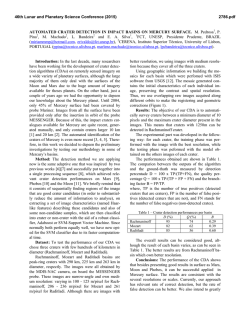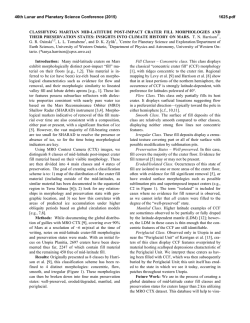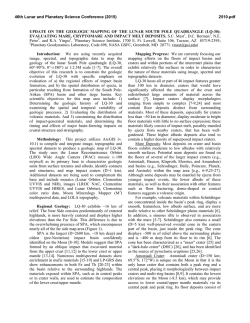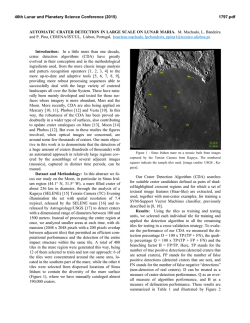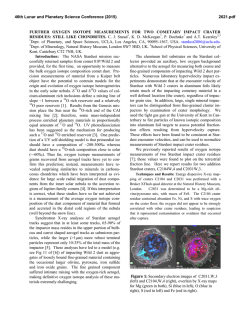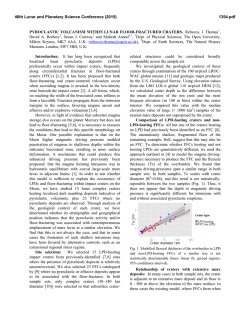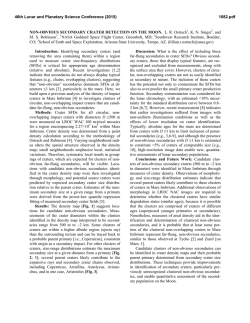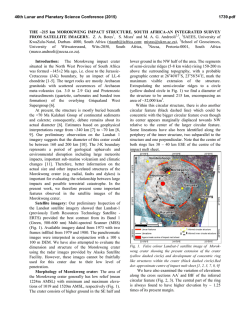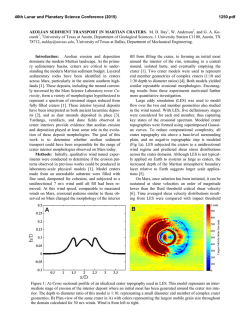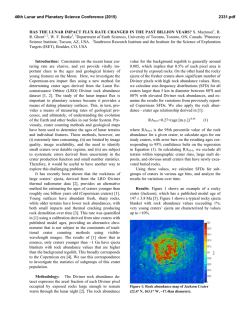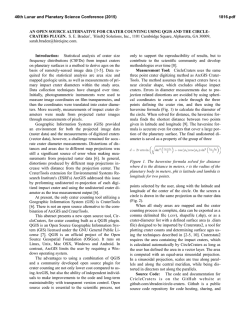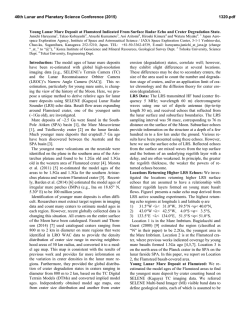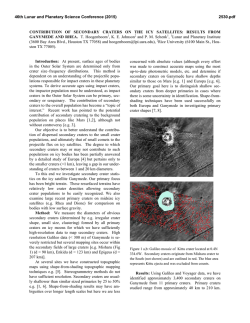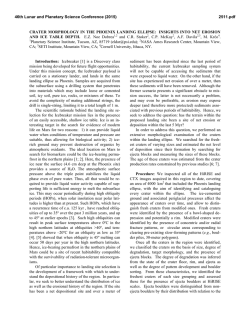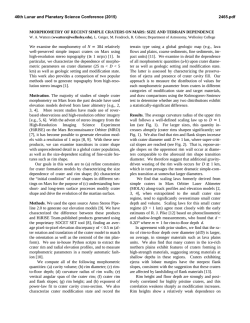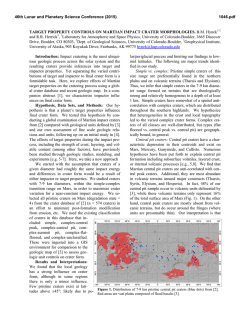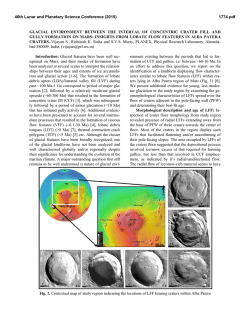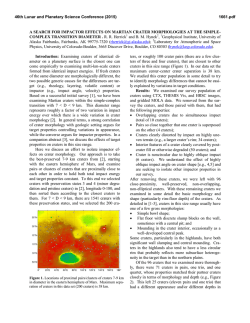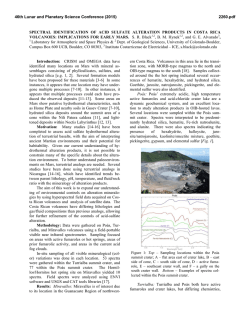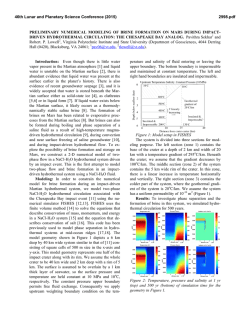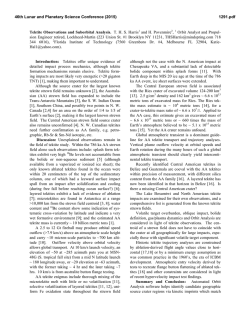
COMPARISON OF LARGE AND MID
46th Lunar and Planetary Science Conference (2015) 2880.pdf COMPARISON OF LARGE AND MID-SIZE LUNAR CRATER DISTRIBUTIONS. R. Z. Povilaitis1, M. S. Robinson1, D. M. Nelson1, L. R. Ostrach1, C. H. van der Bogert2, and H. Hiesinger2, 1School of Earth and Space Exploration, Arizona State University, Tempe, AZ 85287 ([email protected]), 2Institut für Planetologie, Westfälische Wilhelms-Universität, Münster, Germany. Introduction: The rims of a total of 22,746 craters 5 to 20 km in diameter were digitized from a WAC Lunar Reconnaissance Orbiter Camera (LROC) Wide Angle Camera (WAC) mosaic and WAC stereo derived shaded relief maps. A global areal crater density map was created from this crater database ([1] Fig. 1) and compared to a ≥20 km diameter crater density map produced from Lunar Orbiter Laser Altimeter data [2]. Subtracting the 5-20 km diameter density map from the >20 km density map revealed several regions with significant crater density differences. Crater Counts: All craters between ~4 km and ~21 km in diameter (to ensure completeness) were digitized at a scale between 1:250,000 and 1:500,000 in ArcGIS. Basemaps used included: 1) a 100 m/pixel scale WAC monochrome (643 nm) mosaic with an average solar incidence of 60°, and 2) a 100 m/pixel LROC WAC Digital Elevation Model (GLD100 [3]) based shaded relief to help demarcate craters in shadowed regions at the poles and/or subdued craters. Craters outside the 5-20 km diameter range were not used in the creation of the global crater density map. Crater Density: We determined areal crater density for each diameter range (5-20 km and ≥20 km) independently using a moving neighborhood method with a radius of 500 km and an output cell size of 15 km. Density magnitude values for each map were divided into 10 equal-interval bins and reclassified with a ranking of 1 to 10 (1 being lowest density and 10 being highest). The resulting 5-20 km density map (Fig. 1) was subtracted from the ≥20 km density map to produce a crater density difference map (Fig. 2). Output cell values of the difference map range from -4 to +5. Positive difference values represent a high density (red) of ≥20 km craters relative to 5-20 km craters, and negative values represent low density (blue) of ≥20 km craters relative to 5-20 km craters. Discussion: The crater density ratio map allows the investigation of regional and global variations in the densities of mid- to large-scale craters, which provide information about both the ages and resurfacing history of the Moon. The crater density map (Fig. 1) represents a proxy for age, such that it can be used to separate younger (blue) mare units from older (red) highlands units, an aspect also noted by [2] for the density map of ≥20 km diameter craters. Crater size-frequency distributions can be directly extracted for desired count areas from the data set. The ratio of the two density maps allows for the investigation of discrepancies be- tween the two crater-size populations, which draws attention to anomalous regions of interest for more focused studies. For example, the difference map shows a high density difference west of the Mare Australe region (50°S to 70°S, 15°E to 45°E) with a value of +5 (Fig. 3) due to an excess of larger craters relative to the 5-20 km population. In addition, weaker small crater retention due to topographic, regolith, and/or target property effects may also have affected the smaller crater sizes in this area (secondary effect). This +5 region encompasses an area of approximately 1.5x105 km2 and is surrounded by a roughly 6.4x105 km2 positive (+4) relative crater density region (40°S to 80°S, 16°W to 83°E). This area is composed of a variety of ancient geologic units [5] and may be situated at sufficient distance from large resurfacing events (Imbrium, Orientale, and Schrödinger basins) to have retained a larger population of >20 km diameter craters. If this hypothesis is correct, the difference maps elucidate the efficiency of basin forming events to erase craters with diameters greater than 20 km. Two regions south of Mare Moscoviense exhibit a negative crater density difference of -4 (Fig. 4). The two regions (13°N to 28°N, 138°E to 145°E) and (11°N to 24°N, 147°E to 157°E) encompass areas of approximately 5.1x104 km2 and 7.3x104 km2, respectively. Two other negative crater density difference (4) regions east of Mare Moscoviense (10°N to 20°N, 164°E to 179°E) and (2°N to 17°N, 170°W to 159°W) encompass areas of approximately 7.8x104 km2 and 9.9x104 km2, respectively. Previously unrecognized secondaries [4] may have contributed to an overabundance of smaller craters in these four regions. Outlook: We are currently studying the anomalous regions in detail, by incorporating geological maps, data from other studies, and new crater size-frequency distribution measurements with corresponding absolute model ages. These data will help support or refute the proposed effects responsible for the greatest differences shown in the difference maps. References: [1] R. Z. Povilaitis et al. (2013), NLSI Lunar Science Forum [2] Head J.W. et al. (2010) Science 329, 1504-1507 [3] Scholten F. et al. (2012) JGR 117, E00H17 [4] McEwen A.S. and Bierhaus E.B. (2006) Ann. Rev. Earth Planet. Sci. 34, 535–567 [5] Wilhelms, D.E. et al (1979) USGS I-1162 Geologic Map of the South Side of the Moon. 46th Lunar and Planetary Science Conference (2015) 2880.pdf 6 2 Figure 1. Crater density map generated from the measurement of 22,746 craters 5 to 20 km in diameter. Figure 2. Density difference map (>20 km map minus the 5-20 km crater), allowing the comparion of the density of large lunar craters [1], with that of mid-size craters shown in Fig. 1. Figure 3. Anomalous high >20 km crater density area west of Mare Australe. Figure 4. Anomalous high 5-20 km crater density area adjacent to Mare Moscoviense.
© Copyright 2025
